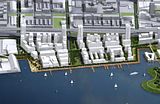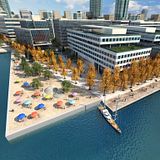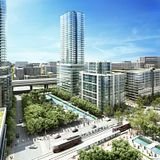You are using an out of date browser. It may not display this or other websites correctly.
You should upgrade or use an alternative browser.
You should upgrade or use an alternative browser.
Waterfront: General Topics
- Thread starter AlvinofDiaspar
- Start date
casaguy
Senior Member
Money flowing fast to Toronto's long-neglected eastern waterfront
Posted: July 24, 2009, 6:07 AM
By Allison Hanes, National Post
In a muddy field saturated by driving summer rain, a fair hike from the nearest condos, office towers or transit routes, politicians from three levels of government braved the deluge yesterday to break ground on the public centrepiece of Toronto’s rapidly transforming eastern waterfront.
As Mayor David Miller pointed out, yesterday’s ceremonial first shovel of dirt at Sherbourne Park was the third big waterfront announcement in a month — and just one of many past and future photo ops sure to be staged in the coming months and years. Sherbourne Park — a $28.7-million, 1.5-hectare green space at the foot of Sherbourne Street on both sides of Queen’s Quay — will anchor a flurry of development taking place east of Jarvis Street.
Right now, that segment of Toronto’s waterfront is an inhospitable, noisy, mucky construction site, harbouring bulldozers, boring machines and cranes. But within a year, the stretch will begin to assume its new roles as a hub for the media industry, with the soon-to-be completed Corus Quay overlooking the park; an educational institution, with the building of a new campus of George Brown College; a residential zone, with new condos likely; and of course a playground, for city residents and tourists.
While many of the projects to rejuvenate Toronto’s long-neglected water’s edge have been filling in gaps among the condos that have sprung up in the past decade from Yonge Street westward, the eastern shore is a blank slate on which city, provincial and federal governments are eager to put their imprimatur.
As a result, the money is flowing fast.
Jim Flaherty, the federal Finance Minister and Cabinet member responsible for the Greater Toronto Area, flew in yesterday morning especially for the soggy event. Ottawa pitched in just over $20-million for Sherbourne Park and has sprinkled dollars all along the lakeshore for projects spearheaded by Waterfront Toronto, the agency responsible for all the redevelopment.
“This underscores our commitment to the waterfront. This is a continuing commitment with respect to which we will persist,†Mr. Flaherty said. “This is a wonderful vision that Waterfront Toronto has. [There is] much more to be done. A lot has been done.â€
George Smitherman, deputy premier of Ontario and the local MPP, also enthused about the park as “Yet further evidence that all of the planning work that Waterfront Toronto has been involved in, is coming to life now in a way that allows us to weave — one bit at a time — a new, beautiful emerging waterfront.â€
A little later, however, Mr. Smitherman, who is also Minister of Infrastructure and Energy, mused about revamping Waterfront Toronto’s governance structure, to free it from its multiple political masters.
“Obviously they’ve picked up momentum and they’re doing some pretty exciting work. But they’ve also called on the province and other levels of government, too, to look at some alteration in the way that they operate,†he said. “We want to make sure that the momentum is not just for the moment, that it’s sustainable and I think it would be an appropriate time to look at whether the rules that govern the operation of Waterfront Toronto are right to keep the momentum going.â€
Mr. Miller — who wants to make the most of redevelopment opportunities along the eastern flank of the downtown waterfront by tearing down the Gardiner Expressway from Jarvis to the Don Valley Parkway — offered a history lesson on the currently unwelcoming real estate.
One hundred years ago, it was actually under water, he noted, until the area was infilled to become an industrial port.
Yesterday, he called the eastern end of the central waterfront, “Toronto’s most sought-after investment opportunity.â€
While Corus Quay, the new hi-tech home of the eponymous media company, is set to open early next year, and George Brown is slated to break ground on its Health Sciences campus this fall, they are only the beginning of the development rush in the east of Toronto’s underused water’s edge.
There are parks, sports fields and transit projects envisioned for the near term with brand-new neighbourhoods planned for the West Don Lands and East Bayfront in the coming decade. And over the next 20 to 30 years, the transformation will creep into the port lands, with Waterfront Toronto recently unveiling a plan to renaturalize the mouth of the Don River and build residences and businesses between the Keating and Shipping Channels to create a Lower Don Lands neighbourhood.
Despite the miserable weather, John Campbell, the president of Waterfront Toronto, the agency responsible for the visioning part of the revitalization, beamed brightly yesterday, as another piece of the puzzle showed the first signs of life.
“With shovels n the ground, the message is clear: Waterfront revitalization is happening and it’s happening now,†he said.
Posted: July 24, 2009, 6:07 AM
By Allison Hanes, National Post
In a muddy field saturated by driving summer rain, a fair hike from the nearest condos, office towers or transit routes, politicians from three levels of government braved the deluge yesterday to break ground on the public centrepiece of Toronto’s rapidly transforming eastern waterfront.
As Mayor David Miller pointed out, yesterday’s ceremonial first shovel of dirt at Sherbourne Park was the third big waterfront announcement in a month — and just one of many past and future photo ops sure to be staged in the coming months and years. Sherbourne Park — a $28.7-million, 1.5-hectare green space at the foot of Sherbourne Street on both sides of Queen’s Quay — will anchor a flurry of development taking place east of Jarvis Street.
Right now, that segment of Toronto’s waterfront is an inhospitable, noisy, mucky construction site, harbouring bulldozers, boring machines and cranes. But within a year, the stretch will begin to assume its new roles as a hub for the media industry, with the soon-to-be completed Corus Quay overlooking the park; an educational institution, with the building of a new campus of George Brown College; a residential zone, with new condos likely; and of course a playground, for city residents and tourists.
While many of the projects to rejuvenate Toronto’s long-neglected water’s edge have been filling in gaps among the condos that have sprung up in the past decade from Yonge Street westward, the eastern shore is a blank slate on which city, provincial and federal governments are eager to put their imprimatur.
As a result, the money is flowing fast.
Jim Flaherty, the federal Finance Minister and Cabinet member responsible for the Greater Toronto Area, flew in yesterday morning especially for the soggy event. Ottawa pitched in just over $20-million for Sherbourne Park and has sprinkled dollars all along the lakeshore for projects spearheaded by Waterfront Toronto, the agency responsible for all the redevelopment.
“This underscores our commitment to the waterfront. This is a continuing commitment with respect to which we will persist,†Mr. Flaherty said. “This is a wonderful vision that Waterfront Toronto has. [There is] much more to be done. A lot has been done.â€
George Smitherman, deputy premier of Ontario and the local MPP, also enthused about the park as “Yet further evidence that all of the planning work that Waterfront Toronto has been involved in, is coming to life now in a way that allows us to weave — one bit at a time — a new, beautiful emerging waterfront.â€
A little later, however, Mr. Smitherman, who is also Minister of Infrastructure and Energy, mused about revamping Waterfront Toronto’s governance structure, to free it from its multiple political masters.
“Obviously they’ve picked up momentum and they’re doing some pretty exciting work. But they’ve also called on the province and other levels of government, too, to look at some alteration in the way that they operate,†he said. “We want to make sure that the momentum is not just for the moment, that it’s sustainable and I think it would be an appropriate time to look at whether the rules that govern the operation of Waterfront Toronto are right to keep the momentum going.â€
Mr. Miller — who wants to make the most of redevelopment opportunities along the eastern flank of the downtown waterfront by tearing down the Gardiner Expressway from Jarvis to the Don Valley Parkway — offered a history lesson on the currently unwelcoming real estate.
One hundred years ago, it was actually under water, he noted, until the area was infilled to become an industrial port.
Yesterday, he called the eastern end of the central waterfront, “Toronto’s most sought-after investment opportunity.â€
While Corus Quay, the new hi-tech home of the eponymous media company, is set to open early next year, and George Brown is slated to break ground on its Health Sciences campus this fall, they are only the beginning of the development rush in the east of Toronto’s underused water’s edge.
There are parks, sports fields and transit projects envisioned for the near term with brand-new neighbourhoods planned for the West Don Lands and East Bayfront in the coming decade. And over the next 20 to 30 years, the transformation will creep into the port lands, with Waterfront Toronto recently unveiling a plan to renaturalize the mouth of the Don River and build residences and businesses between the Keating and Shipping Channels to create a Lower Don Lands neighbourhood.
Despite the miserable weather, John Campbell, the president of Waterfront Toronto, the agency responsible for the visioning part of the revitalization, beamed brightly yesterday, as another piece of the puzzle showed the first signs of life.
“With shovels n the ground, the message is clear: Waterfront revitalization is happening and it’s happening now,†he said.
Jonny5
Senior Member
I walked around the Rees Wave Deck last night and was surprised too see that it has an LED lighting system. Surprised, because it is so poorly implemented, it pretty much illuminates only the underside of the deck. The part that you could only see if you were in one of the boats docked in the water.
EnviroTO
Senior Member
The LED lighting is only supposed to illuminate under the deck but it is supposed to be bright enough to see from dockside. Considering I have walked along the docks and haven't noticed it yet it must not be bright enough. I will have to go walking along there again and pay attention.
Torontovibe
Senior Member
I walked by and I could see that the lights were on but only through tiny slits in the wave deck. You really can't see it in the water. So what's the point if people can't see it? Was it not meant to be seen?
yyzhyd
Active Member
Wonder if it's set to 'low' for the fish habitat below?
EnviroTO
Senior Member
I walked by there today and it is visible dockside and crossing Amsterdam Bridge but it is only bright enough to be noticable in a few places. It will be great in the winter time reflecting off the snow though. I imagine it is very energy efficient and affordable. Too bad there aren't more lights under the wavedecks to brighten it up a bit more.
Automation Gallery
Superstar
From todays Toronto Star article
Three areas of our waterfront mentioned
Wanted: a bold new vision for our fading city
But as a starter, here are some ideas that should be studied now:
On the economic side, we need to look at how to protect and expand our position as a North American financial powerhouse, with the goal of becoming one of the world's top banking centres.
On the waterfront, we need to develop more than just nondescript condos and office buildings. There's not one spectacular building planned for the waterfront, such as a convention centre, that could be used to promote the city.
We need to promote the Toronto City Centre Airport, linking it to the city with a bridge or tunnel and to downtown with a light rail line.
We must make Exhibition Place a focal point for the city, turning it into an incubator for cutting-edge entertainment, cultural and commercial innovation.
Once renowned for our transit system, we are now 30 years behind the world's major cities. We must expand the subway system, add more buses, construct a high-speed line to Pearson Airport.
More................http://www.thestar.com/comment/article/696847
Three areas of our waterfront mentioned
Wanted: a bold new vision for our fading city
But as a starter, here are some ideas that should be studied now:
On the economic side, we need to look at how to protect and expand our position as a North American financial powerhouse, with the goal of becoming one of the world's top banking centres.
On the waterfront, we need to develop more than just nondescript condos and office buildings. There's not one spectacular building planned for the waterfront, such as a convention centre, that could be used to promote the city.
We need to promote the Toronto City Centre Airport, linking it to the city with a bridge or tunnel and to downtown with a light rail line.
We must make Exhibition Place a focal point for the city, turning it into an incubator for cutting-edge entertainment, cultural and commercial innovation.
Once renowned for our transit system, we are now 30 years behind the world's major cities. We must expand the subway system, add more buses, construct a high-speed line to Pearson Airport.
More................http://www.thestar.com/comment/article/696847
lordmandeep
Banned
considering we have such ridership with such a limited system even during the day and weekends , I think its obvious to expand the system even more.
If you built it, they will come and that is true...
If you built it, they will come and that is true...
khris
Senior Member
http://www.theglobeandmail.com/news/national/toronto/ford-office-aiming-to-take-over-port-lands-development/article2144353/The administration of Mayor Rob Ford is moving to seize control of development on the east side of Toronto Harbour, paving the way for ambitious building plans in the Port Lands at the mouth of the Don River and private-sector investment.
Riverdale Rink Rat
Senior Member
Member Bio
- Joined
- Apr 29, 2008
- Messages
- 2,775
- Reaction score
- 273
- Location
- Back to East York... Alas!
While my first reaction was 'how are they going to screw this up?', I'm not sure this is a bad thing. At least it shows the brothers Grim want to speed up the pace (which has been glacial at times.) However, given that Waterfront Toronto has really turned on the taps lately and they could easily have done this through WT, it still sounds like they want to change the direction dramatically rather than speed things up (i.e. more commercial development, less parks). How do they square the circle of the flood plain? I think that's the key to this whole thing.
Automation Gallery
Superstar
While my first reaction was 'how are they going to screw this up?', I'm not sure this is a bad thing. At least it shows the brothers Grim want to speed up the pace (which has been glacial at times.) However, given that Waterfront Toronto has really turned on the taps lately and they could easily have done this through WT, it still sounds like they want to change the direction dramatically rather than speed things up (i.e. more commercial development, less parks). How do they square the circle of the flood plain? I think that's the key to this whole thing.
Hey, throw a couple pedestrian bridges and connect the Portlands with 570 acres of Toronto Islands parkland ....i think its time that we link the islands other than by ferry with the residents of Toronto . I know that my family and a bunch of other people that i know dont go down there because of hassles catching the ferry.
nfitz
Superstar
Agreed. And promising a pedestrian/bike link from Cherry Beach to the Toronto Island was perhaps Rob Ford's only decent promise in the election.Hey, throw a couple pedestrian bridges and connect the Portlands with 570 acres of Toronto Islands parkland ....i think its time that we link the islands other than by ferry with the residents of Toronto.
Though, I doubt he'll deliver on it - and it will be another broken promise.
Marko
Active Member
A bridge/tunnel at either end would really open up the islands to a whole lot more pedestrians, rollerbladers, cyclists and make a far better connection to outer trails than anything down along QQ, which is interrupted at several points.Agreed. And promising a pedestrian/bike link from Cherry Beach to the Toronto Island was perhaps Rob Ford's only decent promise in the election.
Though, I doubt he'll deliver on it - and it will be another broken promise.
EnviroTO
Senior Member
What private developers are going to pay for the bridge without making it capable of handling cars and selling island land to development?











